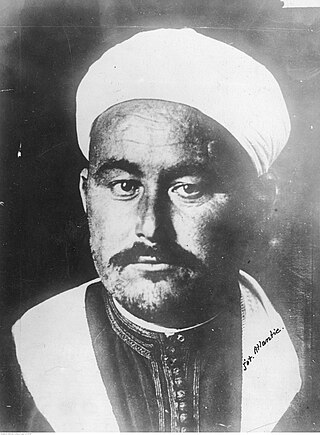
Muhammad bin ‘Abd al-Karīm al-Khaṭābī, better known as Abd el-Krim, was a Moroccan political and military leader and the president of the Republic of the Rif. He and his brother M'Hammad led a large-scale revolt by a coalition of Riffian tribes against the Spanish and French Protectorates of the Rif and the rest of Morocco. His guerrilla tactics, which included the first-ever use of tunneling as a technique of modern warfare, directly influenced Ho Chi Minh, Mao Zedong and Che Guevara. He also became one of the major figures of Arab nationalism, which he actively supported.
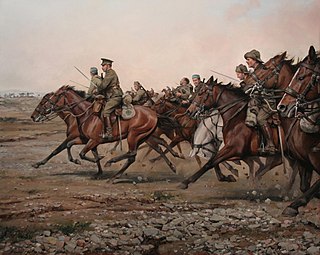
The Battle of Annual was fought on 22 July 1921 at Annual, in northeastern Morocco, between the Spanish Army and Rifian Berbers during the Rif War. The Spanish suffered a major military defeat, which is almost always referred to by the Spanish as the Disaster of Annual which is widely considered to be the worst defeat suffered by the modern Spanish Army.

The Republic of the Rif was a confederate republic in the Rif, Morocco, that existed between 1921 and 1926. It was created in September 1921, when a coalition of Rifians and Jebala led by Abd el-Krim revolted in the Rif War against the Spanish protectorate in Morocco. The French would intervene on the side of Spain in the later stages of the conflict. A protracted struggle for independence killed many Rifians and Spanish–French soldiers, and witnessed the use of chemical weapons by the Spanish army—their first widespread deployment since the end of the World War I. The eventual Spanish–French victory was owed to the technological and manpower advantages despite their lack of morale and coherence. Following the war's end, the Republic was ultimately dissolved in 1926.

The Rif or Riff, also called Rif Mountains, is a geographic region in northern Morocco. It is bordered on the north by the Mediterranean Sea and Spain and on the west by the Atlantic Ocean, and is the homeland of the Rifians and the Jebala people. This mountainous and fertile area is bordered by Cape Spartel and Tangier to the west, by Berkane and the Moulouya River to the east, by the Mediterranean to the north, and by the Ouergha River to the south. The Rif mountains are separated into the eastern Rif mountains and western Rif mountains.
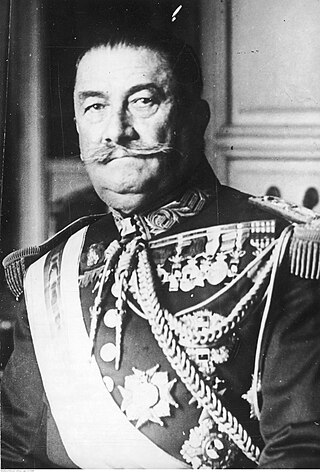
Dámaso Berenguer y Fusté, 1st Count of Xauen was a Spanish general and politician. He served as Prime Minister during the last thirteen months of the reign of Alfonso XIII.
The Army of Africa, also known as the Moroccan Army Corps, was a field army of the Spanish Army that garrisoned the Spanish protectorate in Morocco from 1912 until Morocco's independence in 1956.
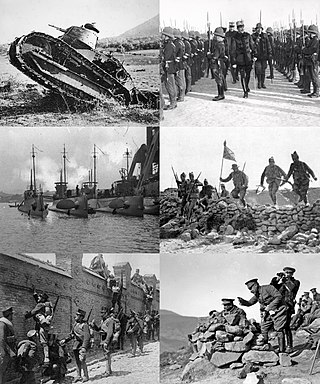
The Rif War was an armed conflict fought from 1921 to 1926 between Spain and the Berber (Amazigh) tribes of the mountainous Rif region of northern Morocco.
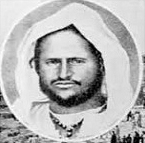
Mohammed ben al-Hajj Amezian, also known as El Mizzian by the Spanish, was a Moroccan sharif who served as the main leader of the Rifian resistance against Spanish rule in northern Morocco prior to the rise of Abd el-Krim in 1921.

The First Melillan Campaign, also called the Melilla War or the Margallo War in Spain, was a conflict between Spain and the Riffian tribes of northeastern Morocco, and later the Sultan of Morocco, that began in October 1893, was openly declared November 9, 1893, and was resolved by the Treaty of Fez in 1894.

The Second Melillan campaign was a conflict in 1909 in northern Morocco around Melilla. The fighting involved local Riffians and the Spanish Army.

Manuel Fernández Silvestre was a Spanish general.
During the Third Rif War in Spanish Morocco between 1921 and 1927, the Spanish Army of Africa deployed chemical weapons in an attempt to put down the Berber rebellion against colonial rule in the region of the Rif led by the guerrilla Abd el-Krim. In 1921, following the Rifian victory in the Battle of Annual, which was considered the worst Spanish defeat of the 20th-century, the Spanish army pursued a campaign of retribution involving the indiscriminate and routine dropping of toxic gas bombs targeting civilian populations, markets and rivers.

Juan Picasso González was a Spanish military man and general who participated in the Rif War with the Spanish Army of Africa in late 19th century and early 20th century. He was a military investigation instructor known for "Expediente Picasso", an investigation report related to the historical defeat of the Spanish Army, some 20,000 soldiers and officers, of which some 8,000 were killed, against the Riffian rebels at the Battle of Annual, on July 1, 1921; known as The disaster of Annual.

Manuel Goded Llopis was a Spanish Army general who was one of the key figures in the July 1936 revolt against the democratic government of Manuel Azanã. Having unsuccessfully led an attempted insurrection in Barcelona, he was captured and executed by the Republican government. Previously, Goded had distinguished himself in the Battle of Alhucemas of the Rif War.
Captain Félix Arenas Gaspar, a Puerto Rican, was a captain in the Spanish Army who was posthumously awarded the Cruz Laureada de San Fernando for his actions in the Rif War.

The Alhucemas landing was a landing operation which took place on 8 September 1925 at Alhucemas by the Spanish Army and Navy and, in lesser numbers, an allied French naval and aerial contingent, that would put an end to the Rif War. It is considered the first amphibious landing in history involving the use of tanks and massive seaborne air support. Alhucemas is seen as a precursor of the Allied amphibious landings in World War II, and the first successful combined operation of the 20th century.

Guillermo Pintos Ledesma was a Spanish Army officer. He took part in the Third Carlist War, the Ten Years' War, the Moro conflict, and the 1895–1898 Cuban War. Promoted to brigadier general in 1905, he was killed in action at a ravine called Barranco del Lobo, during the Second Melillan campaign, leading a column of light infantry that was ambushed by Riffians at the foothills of the Mount Gurugu.
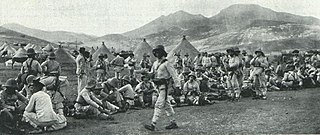
The Kert campaign was a conflict in northern Morocco between Spain and insurgent Riffian harkas led by Mohammed Ameziane, who had called for a jihad against the Spanish occupation in the eastern Rif. It took place between 1911 and 1912.
Abd el-Kader bel Hach Tieb was a Riffian tribal leader, caïd of the Bni Chiker, in northeastern Morocco.

The 1924 retreat from Chefchaoun was the retreat of the Spanish forces from Chefchaouen during the Rif War. After the major defeat at Annual, the prime minister and the military dictator, Miguel Primo de Rivera, decided to withdraw his troops to the coast of Morocco. A major evacuation took place at Chefchaoun where a relief force escorted the garrison to Tetuan. During their march, the Spanish suffered constant attacks by the Riffian force, suffering heavy casualties. The retreat was a disaster for the Spanish army, suffering another devastating loss in the war.
















